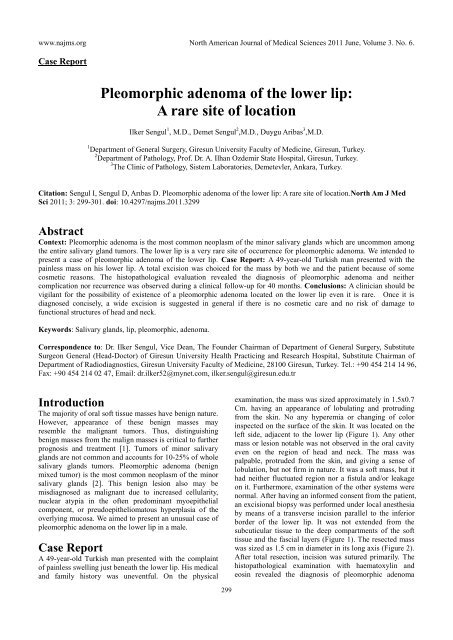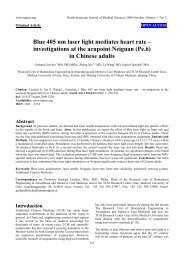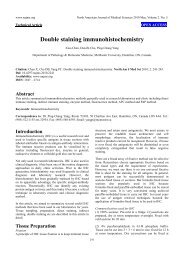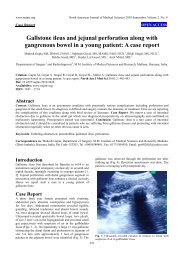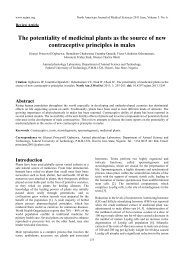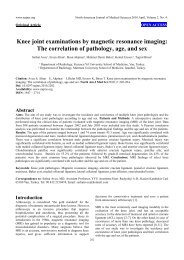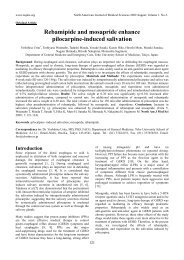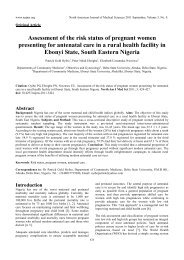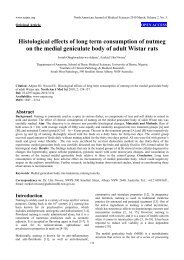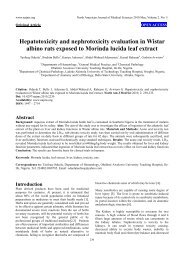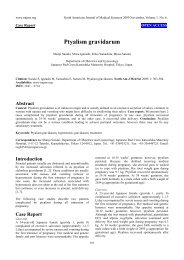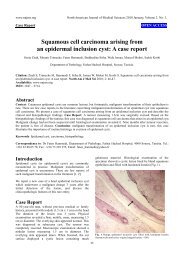Pleomorphic adenoma of the lower lip - North American Journal of ...
Pleomorphic adenoma of the lower lip - North American Journal of ...
Pleomorphic adenoma of the lower lip - North American Journal of ...
You also want an ePaper? Increase the reach of your titles
YUMPU automatically turns print PDFs into web optimized ePapers that Google loves.
www.najms.org <strong>North</strong> <strong>American</strong> <strong>Journal</strong> <strong>of</strong> Medical Sciences 2011 June, Volume 3. No. 6.<br />
Case Report<br />
<strong>Pleomorphic</strong> <strong>adenoma</strong> <strong>of</strong> <strong>the</strong> <strong>lower</strong> <strong>lip</strong>:<br />
A rare site <strong>of</strong> location<br />
Ilker Sengul 1 , M.D., Demet Sengul 2 ,M.D., Duygu Aribas 3 ,M.D.<br />
1 Department <strong>of</strong> General Surgery, Giresun University Faculty <strong>of</strong> Medicine, Giresun, Turkey.<br />
2 Department <strong>of</strong> Pathology, Pr<strong>of</strong>. Dr. A. Ilhan Ozdemir State Hospital, Giresun, Turkey.<br />
3 The Clinic <strong>of</strong> Pathology, Sistem Laboratories, Demetevler, Ankara, Turkey.<br />
Citation: Sengul I, Sengul D, Arıbas D. <strong>Pleomorphic</strong> <strong>adenoma</strong> <strong>of</strong> <strong>the</strong> <strong>lower</strong> <strong>lip</strong>: A rare site <strong>of</strong> location.<strong>North</strong> Am J Med<br />
Sci 2011; 3: 299-301. doi: 10.4297/najms.2011.3299<br />
Abstract<br />
Context: <strong>Pleomorphic</strong> <strong>adenoma</strong> is <strong>the</strong> most common neoplasm <strong>of</strong> <strong>the</strong> minor salivary glands which are uncommon among<br />
<strong>the</strong> entire salivary gland tumors. The <strong>lower</strong> <strong>lip</strong> is a very rare site <strong>of</strong> occurrence for pleomorphic <strong>adenoma</strong>. We intended to<br />
present a case <strong>of</strong> pleomorphic <strong>adenoma</strong> <strong>of</strong> <strong>the</strong> <strong>lower</strong> <strong>lip</strong>. Case Report: A 49-year-old Turkish man presented with <strong>the</strong><br />
painless mass on his <strong>lower</strong> <strong>lip</strong>. A total excision was choiced for <strong>the</strong> mass by both we and <strong>the</strong> patient because <strong>of</strong> some<br />
cosmetic reasons. The histopathological evaluation revealed <strong>the</strong> diagnosis <strong>of</strong> pleomorphic <strong>adenoma</strong> and nei<strong>the</strong>r<br />
complication nor recurrence was observed during a clinical follow-up for 40 months. Conclusions: A clinician should be<br />
vigilant for <strong>the</strong> possibility <strong>of</strong> existence <strong>of</strong> a pleomorphic <strong>adenoma</strong> located on <strong>the</strong> <strong>lower</strong> <strong>lip</strong> even it is rare. Once it is<br />
diagnosed concisely, a wide excision is suggested in general if <strong>the</strong>re is no cosmetic care and no risk <strong>of</strong> damage to<br />
functional structures <strong>of</strong> head and neck.<br />
Keywords: Salivary glands, <strong>lip</strong>, pleomorphic, <strong>adenoma</strong>.<br />
Correspondence to: Dr. Ilker Sengul, Vice Dean, The Founder Chairman <strong>of</strong> Department <strong>of</strong> General Surgery, Substitute<br />
Surgeon General (Head-Doctor) <strong>of</strong> Giresun University Health Practicing and Research Hospital, Substitute Chairman <strong>of</strong><br />
Department <strong>of</strong> Radiodiagnostics, Giresun University Faculty <strong>of</strong> Medicine, 28100 Giresun, Turkey. Tel.: +90 454 214 14 96,<br />
Fax: +90 454 214 02 47, Email: dr.ilker52@mynet.com, ilker.sengul@giresun.edu.tr<br />
Introduction<br />
The majority <strong>of</strong> oral s<strong>of</strong>t tissue masses have benign nature.<br />
However, appearance <strong>of</strong> <strong>the</strong>se benign masses may<br />
resemble <strong>the</strong> malignant tumors. Thus, distinguishing<br />
benign masses from <strong>the</strong> malign masses is critical to fur<strong>the</strong>r<br />
prognosis and treatment [1]. Tumors <strong>of</strong> minor salivary<br />
glands are not common and accounts for 10-25% <strong>of</strong> whole<br />
salivary glands tumors. <strong>Pleomorphic</strong> <strong>adenoma</strong> (benign<br />
mixed tumor) is <strong>the</strong> most common neoplasm <strong>of</strong> <strong>the</strong> minor<br />
salivary glands [2]. This benign lesion also may be<br />
misdiagnosed as malignant due to increased cellularity,<br />
nuclear atypia in <strong>the</strong> <strong>of</strong>ten predominant myoepi<strong>the</strong>lial<br />
component, or preudoepi<strong>the</strong>liomatous hyperplasia <strong>of</strong> <strong>the</strong><br />
overlying mucosa. We aimed to present an unusual case <strong>of</strong><br />
pleomorphic <strong>adenoma</strong> on <strong>the</strong> <strong>lower</strong> <strong>lip</strong> in a male.<br />
Case Report<br />
A 49-year-old Turkish man presented with <strong>the</strong> complaint<br />
<strong>of</strong> painless swelling just beneath <strong>the</strong> <strong>lower</strong> <strong>lip</strong>. His medical<br />
and family history was uneventful. On <strong>the</strong> physical<br />
299<br />
examination, <strong>the</strong> mass was sized approximately in 1.5x0.7<br />
Cm. having an appearance <strong>of</strong> lobulating and protruding<br />
from <strong>the</strong> skin. No any hyperemia or changing <strong>of</strong> color<br />
inspected on <strong>the</strong> surface <strong>of</strong> <strong>the</strong> skin. It was located on <strong>the</strong><br />
left side, adjacent to <strong>the</strong> <strong>lower</strong> <strong>lip</strong> (Figure 1). Any o<strong>the</strong>r<br />
mass or lesion notable was not observed in <strong>the</strong> oral cavity<br />
even on <strong>the</strong> region <strong>of</strong> head and neck. The mass was<br />
palpable, protruded from <strong>the</strong> skin, and giving a sense <strong>of</strong><br />
lobulation, but not firm in nature. It was a s<strong>of</strong>t mass, but it<br />
had nei<strong>the</strong>r fluctuated region nor a fistula and/or leakage<br />
on it. Fur<strong>the</strong>rmore, examination <strong>of</strong> <strong>the</strong> o<strong>the</strong>r systems were<br />
normal. After having an informed consent from <strong>the</strong> patient,<br />
an excisional biopsy was performed under local anes<strong>the</strong>sia<br />
by means <strong>of</strong> a transverse incision parallel to <strong>the</strong> inferior<br />
border <strong>of</strong> <strong>the</strong> <strong>lower</strong> <strong>lip</strong>. It was not extended from <strong>the</strong><br />
subcuticular tissue to <strong>the</strong> deep compartments <strong>of</strong> <strong>the</strong> s<strong>of</strong>t<br />
tissue and <strong>the</strong> fascial layers (Figure 1). The resected mass<br />
was sized as 1.5 cm in diameter in its long axis (Figure 2).<br />
After total resection, incision was sutured primarily. The<br />
histopathological examination with haematoxylin and<br />
eosin revealed <strong>the</strong> diagnosis <strong>of</strong> pleomorphic <strong>adenoma</strong>
www.najms.org <strong>North</strong> <strong>American</strong> <strong>Journal</strong> <strong>of</strong> Medical Sciences 2011 June, Volume 3. No. 6.<br />
(Figure 3). The patient recovered uneventfully and clinical<br />
follow-up for 40 months after resection exhibited no<br />
evidence <strong>of</strong> local recurrence or o<strong>the</strong>r occurrence on <strong>the</strong><br />
head and neck and <strong>the</strong> o<strong>the</strong>r parts <strong>of</strong> <strong>the</strong> body.<br />
Fig. 1 Exploration <strong>of</strong> <strong>the</strong> mass after a transverse incision, parallel<br />
to <strong>the</strong> inferior border <strong>of</strong> <strong>the</strong> <strong>lower</strong> <strong>lip</strong>.<br />
Fig. 2 The size <strong>of</strong> <strong>the</strong> long axis <strong>of</strong> <strong>the</strong> resected mass is seen as 1.5<br />
cm in diameter.<br />
Fig. 3 The glandular structures having basal myoepi<strong>the</strong>lial<br />
components on <strong>the</strong> chondromyxoid background (Haematoxylin<br />
and Eosin, Original magnification, 5x10) .<br />
Discussion<br />
The most common tumor <strong>of</strong> minor salivary glands,<br />
accounting 40 %, may be found in larynx, nasal cavity,<br />
and paranasal sinuses. In <strong>the</strong> term <strong>of</strong> extra-major salivary<br />
gland pleomorphic <strong>adenoma</strong>, <strong>the</strong> most frequent occurrence<br />
was reported as palate, followed by upper <strong>lip</strong>. <strong>Pleomorphic</strong><br />
<strong>adenoma</strong> <strong>of</strong> minor salivary glands mostly seen in female<br />
gender [3]. So, we purposed to present a pleomorphic<br />
<strong>adenoma</strong>, located on <strong>the</strong> <strong>lower</strong> <strong>lip</strong> and found in a male.<br />
This location is a rare site <strong>of</strong> occurrence for pleomorphic<br />
<strong>adenoma</strong>. Al-Khateeb et al [1] evaluated <strong>the</strong> relative<br />
frequencies, types and distribution <strong>of</strong> benign oral masses<br />
in <strong>North</strong> Jordanians. A total <strong>of</strong> 818 cases with benign oral<br />
s<strong>of</strong>t tissue masses retrospectively analyzed for an 11-year<br />
period and <strong>the</strong> parameters <strong>of</strong> age, sex, mass type and<br />
location were measured. Common benign neoplasms were<br />
salivary pleomorphic <strong>adenoma</strong> and <strong>lip</strong>oma. Most frequent<br />
non-neoplastic lesion was traumatic (43%). Male to<br />
female ratio and <strong>the</strong> mean age was detected as 1:1.5 and<br />
33 years, respectively. The palate, tongue, upper <strong>lip</strong> and<br />
buccal mucosa, were <strong>the</strong> sites commonly affected by<br />
benign neoplasms in a descending order. Of 818 cases a<br />
sum <strong>of</strong> 13 pleomorphic <strong>adenoma</strong> (2%) were determined,<br />
mostly in <strong>the</strong> patients between <strong>the</strong> ages <strong>of</strong> 21-30 years<br />
(6/13). The cases <strong>of</strong> pleomorphic <strong>adenoma</strong> were located<br />
mostly in <strong>the</strong> palate (8/13). Three <strong>of</strong> <strong>the</strong>m was on <strong>the</strong><br />
upper <strong>lip</strong> and only one found in <strong>the</strong> gingiva (1/13) and one<br />
in <strong>the</strong> <strong>lower</strong> <strong>lip</strong> (1/13). In general, only one patient (1/818)<br />
was <strong>the</strong> case <strong>of</strong> pleomorphic <strong>adenoma</strong> <strong>of</strong> <strong>the</strong> <strong>lower</strong> <strong>lip</strong> in<br />
that wide analysis <strong>of</strong> benign oral masses in a <strong>North</strong><br />
Jordanian population during an 11-year period. According<br />
to our knowledge, <strong>the</strong> number <strong>of</strong> <strong>the</strong> cases <strong>of</strong> pleomorphic<br />
<strong>adenoma</strong> <strong>of</strong> <strong>the</strong> <strong>lower</strong> <strong>lip</strong> which were presented in <strong>the</strong><br />
literature, indexed in Medline have been a very limited<br />
number. Besides, our case is <strong>the</strong> first case from Turkey<br />
among <strong>the</strong> mentioned literature [4].<br />
In <strong>the</strong> treatment <strong>of</strong> pleomorphic <strong>adenoma</strong>, wide resection<br />
with negative margins is frequently recommended as an<br />
optimal choice. Because, almost half <strong>of</strong> all tumors<br />
originating from minor salivary glands are proclaimed as<br />
malignant. So, even fine-needle aspiration or incisional<br />
biopsy was suggested before <strong>the</strong> definitive surgery.<br />
Additionally, a recurrence rate <strong>of</strong> 2-44 % has been<br />
declared in <strong>the</strong> literature since 1939 [3]. Krolls et al [5]<br />
asserted that inefficient first surgical intervention was <strong>the</strong><br />
main cause <strong>of</strong> recurrences. However, Dongre et al [6]<br />
propounded that simple excision was <strong>the</strong> only treatment<br />
for it. Disadvantages <strong>of</strong> wide excision <strong>of</strong> extra-major<br />
salivary gland pleomorphic <strong>adenoma</strong> may be summarized<br />
as cosmetic care particularly for upper and <strong>lower</strong> <strong>lip</strong>s, eyes,<br />
and face in general, and probability <strong>of</strong> injury to functional<br />
structures <strong>of</strong> head and neck such as upper and <strong>lower</strong> <strong>lip</strong>,<br />
and palate. So, we and <strong>the</strong> patient choiced just a total<br />
excision for <strong>the</strong> mass <strong>of</strong> <strong>the</strong> presented case due to some<br />
cosmetic reasons. The patient recovered uneventfully and<br />
no recurrence was observed during a clinical follow-up for<br />
40 months. However, we <strong>of</strong>fer wide excision for <strong>the</strong><br />
treatment <strong>of</strong> extra-major salivary gland pleomorphic<br />
<strong>adenoma</strong> especially for <strong>the</strong> selected cases.<br />
In summary, tumors <strong>of</strong> <strong>the</strong> minor salivary glands are<br />
uncommon among entire salivary glands tumors.<br />
300
www.najms.org <strong>North</strong> <strong>American</strong> <strong>Journal</strong> <strong>of</strong> Medical Sciences 2011 June, Volume 3. No. 6.<br />
<strong>Pleomorphic</strong> <strong>adenoma</strong> is <strong>the</strong> most frequent neoplasm <strong>of</strong><br />
<strong>the</strong> minor salivary glands, mostly seen in women. The <strong>lip</strong><br />
is a rare site <strong>of</strong> occurrence for pleomorphic <strong>adenoma</strong>.<br />
Besides, <strong>the</strong> <strong>lower</strong> <strong>lip</strong> is a more seldom location than <strong>the</strong><br />
upper <strong>lip</strong>. So, we presented a pleomorphic <strong>adenoma</strong> <strong>of</strong> <strong>the</strong><br />
<strong>lower</strong> <strong>lip</strong> in a man. Wide surgical excision is<br />
recommended due to possibility <strong>of</strong> both recurrence and<br />
being a malignant tumor after a pathological examination.<br />
However, this technique may be compromised and<br />
problematic because <strong>of</strong> cosmetic reasons and likelihood <strong>of</strong><br />
damage to functional structures.<br />
We would like to emphasize that a clinician must be<br />
vigilant for <strong>the</strong> possibility <strong>of</strong> a mass on <strong>the</strong> <strong>lower</strong> <strong>lip</strong> may<br />
being a pleomorphic <strong>adenoma</strong> or a malignant form <strong>of</strong> it<br />
though it is a rare site <strong>of</strong> occurrence. Besides this,<br />
approximately 50 % <strong>of</strong> all tumors derived from <strong>the</strong> minor<br />
salivary glands are malignant.<br />
Acknowledgement<br />
It is not used an funding for <strong>the</strong> present work. All authors<br />
contributed equally and were involved in writing <strong>the</strong> paper<br />
and finally approved <strong>the</strong> submitted and published versions<br />
without any conflict <strong>of</strong> interest.<br />
References<br />
1. Al-Khateeb TH. Benign Oral Masses in a Nor<strong>the</strong>rn<br />
Jordanian Population-a Retrospective Study. Open<br />
Dent J 2009; 3:147-153.<br />
2. Spiro RH. Salivary neoplasms: overview <strong>of</strong> a 35 year<br />
experience with 2807 patients. Head Heck Surg<br />
1986; 8:177-184.<br />
3. Kuo YL, Tu TY, Chang CF, et al. Extra-major<br />
salivary gland pleomorphic <strong>adenoma</strong> <strong>of</strong> <strong>the</strong> head and<br />
neck: a 10-year experience and review <strong>of</strong> <strong>the</strong><br />
literature. Eur Arch Otorhinolaryngol 2010 Dec 1.<br />
DOI 10.1007/s00405-010-1437-2 [Epub ahead <strong>of</strong><br />
print].<br />
4. Sengul I, Sengul D. <strong>Pleomorphic</strong> <strong>adenoma</strong> <strong>of</strong> <strong>the</strong><br />
<strong>lower</strong> <strong>lip</strong>. <strong>North</strong> Am J Med Sci (In Press).<br />
5. Krolls SO, Boyers RC. Mixed tumors <strong>of</strong> salivary<br />
glands. Long-term follow-up. Cancer 1972; 30:<br />
276-81.<br />
6. Dongre A, Khopkar U. Asymptomatic nodule on <strong>lip</strong>.<br />
Indian J Dermatol Venereol Leprol 2006;72:470.<br />
301


